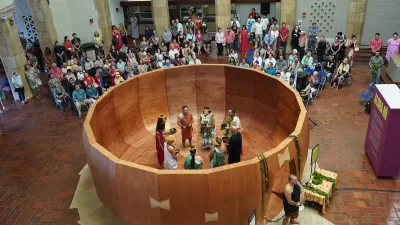Following George Floyd’s murder in 2020, there was an explosion of anti-racist street art across the country. “When we allow ourselves to release our emotions, oftentimes what is produced out of that is art.”

Amid the nationwide uprisings that sprang up after the murder of George Floyd at the hands of police in May 2020, protesters in several cities held their ground by occupying street corners, setting up tents in public squares, and even declaring entire city blocks autonomous zones until local governments adopted demands to defund police or take steps to dismantle policies and institutions that marginalize Black Americans.
More than a year later, many of these spaces have been cleared of the remnants of those occupations. While the demonstrators’ demands—in most situations—were not met, the occupations did invigorate new life into spaces that had been sites or symbols of white supremacy.
According to a team of researchers at the University of St. Thomas in St. Paul, Minnesota, following Floyd’s murder there was an explosion of anti-racist street art across the country, and these researchers believe it could be “the largest global explosion of street art addressing one single event or subject in history.”
Two sites that received significant attention were in Minneapolis, Minnesota, and Richmond, Virginia. It’s not surprising that the most notable art can be found in Minneapolis at the intersection of 28th and Chicago, the street corner where Floyd died. The area, which activists refer to as George Floyd Square, is bursting with art. The most noticeable piece is a black steel fist that was erected in the middle of the intersection. Gripping a Black liberation flag and surrounded by photos of victims of police brutality, the starkness of the sculpture forces people to slow down and take in the history and tragedy that took place there.
“Look at the way in which people claim the space, how it became a kind of blank canvas, and they began to design it themselves. . . . Within people is an innate ability to create and imagine designs for themselves,” says Jeanelle Austin, a volunteer caretaker at the memorial site. She grew up and lives just two blocks from where Floyd was killed, and believes that in the year following Floyd’s death, the space has taken on a spiritual energy. “It was the people, the community, that came together and imbued it as a sacred space the day that George Floyd was lynched.”
Austin sees the art found throughout 38th and Chicago as offerings. “What some people call art, I call expressions of pain.” These expressions of pain, Austin explains, are important to addressing the institution of white supremacy. “People telling the story about what they are going through or what they have gone through with the Minneapolis uprising,” is incredibly important, says Austin, “because when we look at the tie between racism and story, the history of racism is rooted in the stripping of story and the stripping of narrative.”
A few works of art raised conflict and criticism from the community. For instance ...
FULL STORY: The Racial Reckoning in Public Spaces

Study: Maui’s Plan to Convert Vacation Rentals to Long-Term Housing Could Cause Nearly $1 Billion Economic Loss
The plan would reduce visitor accommodation by 25% resulting in 1,900 jobs lost.

Alabama: Trump Terminates Settlements for Black Communities Harmed By Raw Sewage
Trump deemed the landmark civil rights agreement “illegal DEI and environmental justice policy.”

Why Should We Subsidize Public Transportation?
Many public transit agencies face financial stress due to rising costs, declining fare revenue, and declining subsidies. Transit advocates must provide a strong business case for increasing public transit funding.

Paris Bike Boom Leads to Steep Drop in Air Pollution
The French city’s air quality has improved dramatically in the past 20 years, coinciding with a growth in cycling.

Why Housing Costs More to Build in California Than in Texas
Hard costs like labor and materials combined with ‘soft’ costs such as permitting make building in the San Francisco Bay Area almost three times as costly as in Texas cities.

San Diego County Sees a Rise in Urban Coyotes
San Diego County experiences a rise in urban coyotes, as sightings become prevalent throughout its urban neighbourhoods and surrounding areas.
Urban Design for Planners 1: Software Tools
This six-course series explores essential urban design concepts using open source software and equips planners with the tools they need to participate fully in the urban design process.
Planning for Universal Design
Learn the tools for implementing Universal Design in planning regulations.
Smith Gee Studio
Alamo Area Metropolitan Planning Organization
City of Santa Clarita
Institute for Housing and Urban Development Studies (IHS)
City of Grandview
Harvard GSD Executive Education
Toledo-Lucas County Plan Commissions
Salt Lake City
NYU Wagner Graduate School of Public Service



























